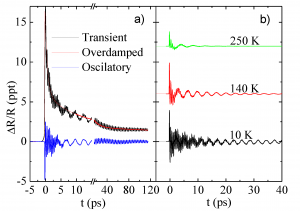Ultrafast dynamics

The use of ultrashort light pulses from the modern femtosecond lasers in scientific research has enabled an insight into fundamental processes and interactions in nature on a time scale of less than 1 ps (1 ps = 0. 000 000 000 001 s), which is a starting point for understanding a large number of macroscopic processes not only in physics but also in chemistry and biology. Ultra-fast spectroscopy is a modern laser technique that studies dynamics of molecules, molecular complexes in various types of design, shape and size, and deals with time-domain response of matter (in the solid, liquid or a gaseous state) to the excitation with ultrashort light pulses. This provides information on the dynamics of basic physical processes in nature such as photosynthesis, intramolecular energy transfer, chemical bond formation, photopolymerization, photodegradation, electron and lattice dynamics, etc.
Along with a very high temporal resolution, the importance of femtosecond lasers lies in the ability to achieve extremely high powers of laser pulses. Thus, their application expands to a whole range of nonlinear phenomena in light-matter interaction, including inducing and investigating metastable ground states in solids that are not possible in the thermal equilibrium.
